The Motorola Moto G4 and G4 Plus Review
by Brandon Chester on August 15, 2016 8:00 AM EST- Posted in
- Smartphones
- Lenovo
- Motorola
- Moto G
- Moto G4
GPU Performance
As I mentioned on the last page, moving from Snapdragon 410 to Snapdragon 617 doesn't really lead to a significant improvement in real-world CPU performance. What does improve is GPU performance, which is something that has always been a bit of a problem on low-end and mid-range smartphones. The 2015 Moto G used Qualcomm's Snapdragon 410 SoC. Snapdragon 410 uses Qualcomm's Adreno 306 GPU, which put the 2015 Moto G in a bit of an odd position because that same SoC was used in the significantly cheaper Moto E. Snapdragon 617 uses Adreno 405, which we've demonstrated as providing significantly faster performance than Adreno 306 in past reviews of other devices that use it. It's worth testing a device to ensure everything is working correctly even if you already have results for another device with the same SoC, and so I've run our 2016 GPU benchmarks on the Moto G4.
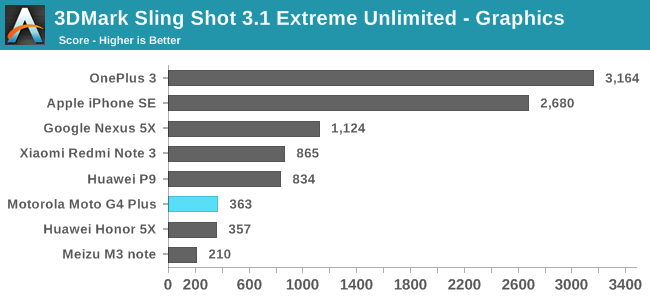
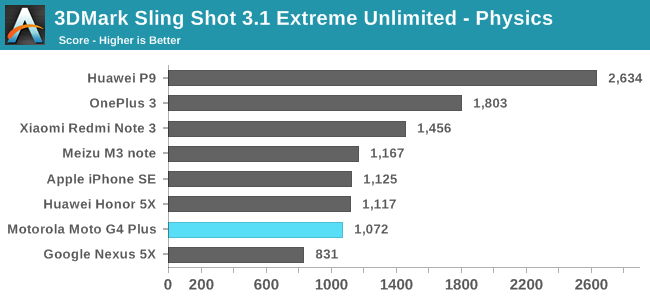
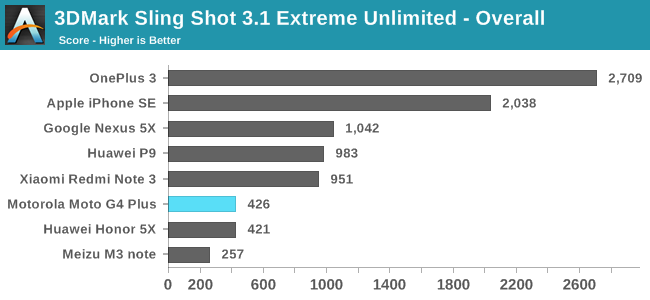
The 2015 Moto G doesn't support OpenGL ES 3.1, and so there's no way to run 3DMark Sling Shot Extreme Unlimited which uses ES 3.1 on Android and Metal on iOS. Snapdragon 617 uses the same Adreno 405 GPU as Snapdragon 615, and you can see in the results that the performance is right in line with the Huawei Honor 5X which uses Snapdragon 615. For a mid-range phone this is generally good performance, but once again the Xiaomi Redmi Note 3 sits far ahead of the rest of the mid-range smartphones, including the Moto G4.
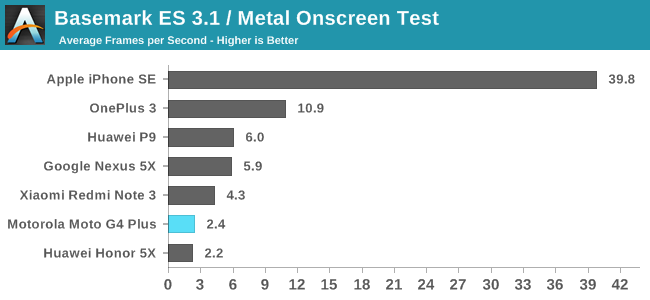
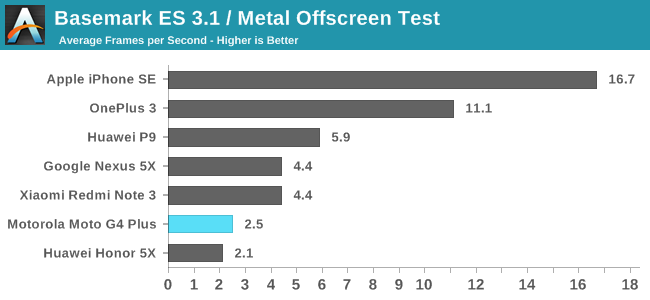
The situation in BaseMark ES 3.1 is the same as 3DMark, with the G4 Plus achieving roughly the same performance as the Huawei Honor 5X. The Xiaomi Redmi Note 3 with its Adreno 510 GPU ends up being a little over 75% faster, which is a huge improvement even if both devices technically don't get close to a playable frame rate in this very heavy test.
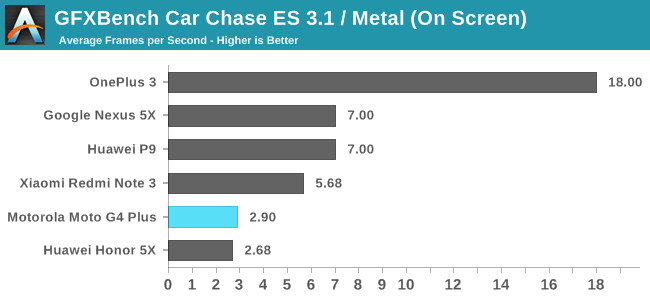
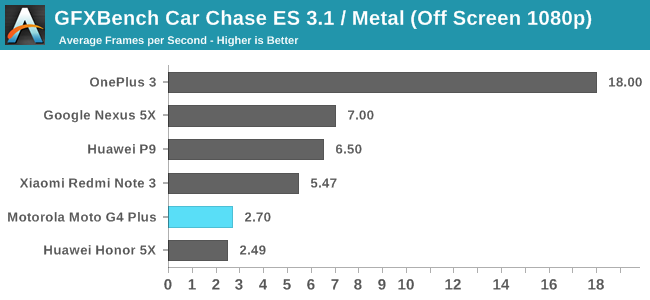
In GFXBench Car Chase it's the story is the same. The Moto G4 Plus is in line with other Adreno 405 devices, but the question is really whether or not that's good enough for a device launching this late into 2016.
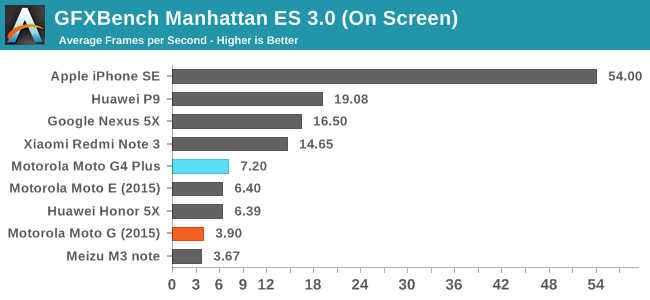
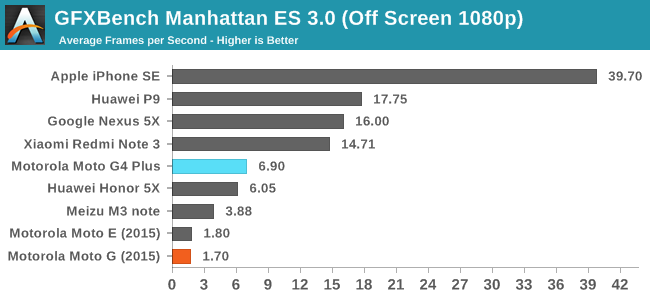
We've generally moved to Manhattan ES 3.1 / Metal for our reviews, but in cases like this where a device's predecessor doesn't support OpenGL ES 3.1 it's helpful to bring back Manhattan ES 3.0 to do a direct performance comparison. As expected, the Moto G4 is much faster than the 2015 Moto G, with on screen performance being about 85% faster despite the move from 720p to 1080p. and off screen performance being over four times faster.
It's clear that the Moto G4 provides much better GPU performance that the 2015 Moto G. However, much like the CPU benchmarks, I keep looking at the charts and seeing the Xiaomi Redmi Note 3 sitting well above the Moto G4. Adreno 405 is much better than Adreno 306, but Adreno 510 is two times faster than Adreno 405. I feel like the Moto G4 is simply launching too late for this kind of performance to be competitive, as it's tied with the Honor 5X which was launched at $200 nearly a year ago. While I don't mean to take away from the fact that the Moto G4 does provide faster GPU performance than its predecessor, I think there are devices right around the corner that are going to make a mid-range smartphone with Snapdragon 617 look decidedly last generation.
NAND Performance
NAND performance is still an area of concern on mid-range smartphones, but the situation has gotten better in recent times. The 2015 Moto E was an example of a device with very poor NAND performance, but the 2015 Moto G was significantly faster across the board. Motorola is still using eMMC memory, but there's definitely room for improvement over the 2015 Moto G even when sticking with an eMMC storage solution. To evaluate the Moto G4's storage performance I've run AndroBench 4.0 on both the 16GB Moto G4 and the 64GB Moto G4 Plus.
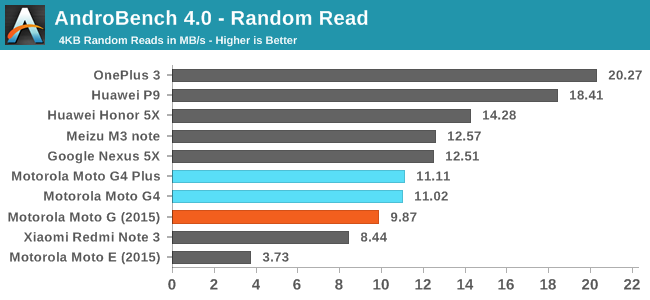
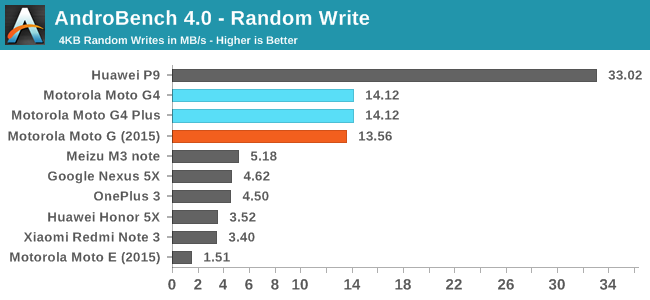
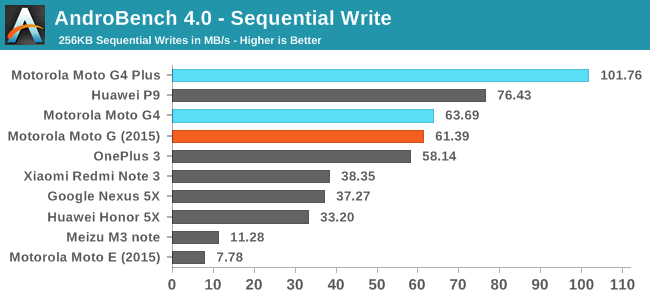

Among mid-range devices, the 64GB Moto G4 Plus performs very well. Random write results are ahead of all other devices on the chart except the Huawei P9, which isn't really a mid-range device and is just there for SoC comparisons. In the sequential write test the Moto G4 leads, which is due in part to the larger capacity allowing greater write parallelism. Sequential read performance is very good as well, although obviously not competitive with UFS 2.0 storage solutions like the one used in the OnePlus 3.










94 Comments
View All Comments
Dribble - Monday, August 15, 2016 - link
It is a fair point - there are very few good small phones, you've got the Sony Z? compact and that's about it. This has just released itself right into the mass of cheap chinese phones some of which are better.Tbh the original moto g nailed it - small phone with replaceable back for compact folding cover, good screen, good performance, good battery life. My son still has one, it still works, the screen still has 0 scratches due to great cover, the battery life is still acceptable. The subsequent moto g'd all got bigger, slower, worse battery life, etc. Whoever is in charge just doesn't have a clue imo.
All motorola had to do was produce something the same as the original moto g for 2016 and it would have had the whole market between cheap n nasty and the sony Z? compact. Been really popular with people who want a compact phone but don't want to spend a fortune and parents looking for a phone that will fit in their kids pocket and that they won't break in 5 minutes.
BrokenCrayons - Monday, August 15, 2016 - link
Larger phones are nice for the added screen space, but I do agree that 5.5" is too large. I prefer sub-4 inch screens since they're much more easily carried. Its comical to see people with belt holsters and huge, awkward protective cases wrapped around gigantic phones that are worn like cowboys in those silly western movies used to wear their revolvers. I'm just waiting for one giant phone owner to spit out tobacco and say "Draw pilgrim," to another giant phone owner. Then again, I think a lot of the appeal in larger phones is to show off technology while feeling trendy and well-connected. These days, the phone someone openly carries in a holster is as much a status symbol as the huge SUV that same person jammed into two parking spaces at their local grocery store.Michael Bay - Monday, August 15, 2016 - link
5.5 is too large, but sub-4 is too small. Where have all the 4.7s went? It was the best of both...markiz - Monday, August 15, 2016 - link
How can you have ANYTHING done on a sub 4" screen?Browsing, reading, looking at photos, satnav, ebooks, gaming.. None of these thing can be done on such a tiny screen with any level of comfort.
Michael Bay - Tuesday, August 16, 2016 - link
Well, if you actually use your phone as a PHONE, it`s handy.Foreign concept nowadays, I know.
johnsonx - Monday, August 15, 2016 - link
same here... having gone from 3" to 3.6" to 4.5" to 5" to 5.7" to now 6" in the last 5 years, I would not even consider anything less than 5.5" for my next phone. I'm finding I quite like the 6" size, but it may be bigger than absolutely necessary.I still have my old 3" Palm Pre+ from 2010 sitting in a drawer... it seems comically small now, even given that it has a slide-out physical keyboard. And to think, I read several e-books on that screen.
mrochester - Monday, August 15, 2016 - link
Broadly, people are stupid. They think bigger numbers = better.zeeBomb - Monday, August 15, 2016 - link
I wish the did that too...maybe with another Moto device? It is what it is...Geranium - Monday, August 15, 2016 - link
@AnandTech,Whey are you guys putting Android benchmark result and iOS benchmark result in same chart?
They are different platforms and runs on different runtime and APIs. I think they are not comparable.
close - Monday, August 15, 2016 - link
Whether Kraken is or isn't a good indicator fro real life performance might be up for debate but this doesn't take away from the value of a synthetic benchmark.You run the same benchmark on two devices as different as they may be and come up with a result. Imagine an addition benchmark done on a computer and on a piece of paper then claiming it's not fair because pen and paper are a completely different platform. The purpose of the benchmark is met, you now know that using brain+pen+paper is a lot slower than using a CPU.